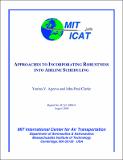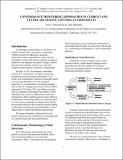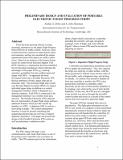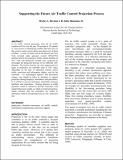Browsing ICAT - Reports and Papers by Subject "air traffic control"
Now showing items 1-14 of 14
-
Approaches to Incorporating Robustness into Airline Scheduling
(2000-08)The airline scheduling process used by major airlines today aims to develop opti- mal schedules which maximize revenue. However, these schedules are often far from \optimal" once deployed in the real world because they ... -
Conformance Monitoring Approaches in Current and Future Air Traffic Control Environments
(2002-10)Conformance monitoring is a core task in Air Traffic Control (ATC) operations to determine whether aircraft are adhering to assigned trajectories. This is important for many reasons, including to ensure that tactical ... -
Design And Evaluation Of A Portable Electronic Flight Progress Strip System
(MIT International Center for Air Transportation, 2003-06)There has been growing interest in using electronic alternatives to the paper Flight Progress Strip (FPS) for air traffic control. However, most research has been centered on radar-based control environments, and has not ... -
Evaluation of Regional Jet Operating Patterns in
(2004-05)Airlines are increasingly using regional jets to better match aircraft size to high value, but limited demand markets. The increase in regional jet usage represents a significant change from traditional air traffic ... -
Experimental Evaluation Of Portable Electronic Flight Progress Strips
(2004-10)Air traffic service providers are increasingly embracing electronic alternatives to the traditional paper Flight Progress Strip (FPS). However, most development of such electronic systems, and of Decision Support Tools ... -
Experimental Studies of the Effect of Intent Information on
(Internationa, 1997-05)Intent information provides knowledge of another aircraft’s current and future trajectory states. Prototype traffic displays were designed for four different levels of intent: Position, Rate, Commanded State, and FMS-Path. ... -
Identification of Communication and Coordination Issues in the U. S. Air Traffic Control System
(2001-06)Today’s air traffic control system is approaching the point of saturation, as evidenced by increasing delays across the National Airspace System (NAS). There exists an opportunity to enhance NAS efficiency and reduce ... -
Impact of Operating Context on the Use of Structure in Air Traffic Controller Cognitive Processes
(2003-06-23)This paper investigates the influence of structure on air traffic controllers’ cognitive processes in the TRACON, En Route, and Oceanic environments. Radar data and voice command analyses were conducted to support hypotheses ... -
Investigating Conformance Monitoring Issues in Air Traffic Control Using Fault Detection Approaches
(2003-11)In order to maintain Air Traffic Control (ATC) system safety, security and efficiency, conformance monitoring must be performed to ensure that aircraft adhere to their assigned clearances. New Decision Support Tools ... -
Pilot Perception and Use of ADS-B Traffic and Weather Services (TIS-B & FIS-B)
(2014-10-08)Automatic Dependent Surveillance – Broadcast (ADS-B) is a central component of the NextGen air traffic control modernization program. It is intended to improve traffic surveillance capabilities by sharing accurate aircraft ... -
Preliminary Design and Evaluation of Portable Electronic Flight Progress Strips
(2002-10)There has been growing interest in using electronic alternatives to the paper Flight Progress Strip (FPS) for air traffic control. However, most research has been centered on radar-based control environments, and has not ... -
Structure, Intent & Conformance Monitoring in ATC
(2002-09)In field studies of current Air Traffic Control operations it is found that controllers rely on underlying airspace structure to reduce the complexity of the planning and conformance monitoring tasks. The structure appears ... -
Supporting the Future Air Traffic Control Projection Process
(International Center for Air Transportation, 2003)In air traffic control, projecting what the air traffic situation will be over the next 30 seconds to 30 minutes is a key process in identifying conflicts that may arise so that evasive action can be taken upon discovery ... -
Use of Structure as a Basis for Abstraction in Air Traffic Control
(2003-03)The safety and efficiency of the air traffic control domain is highly dependent on the capabilities and limitations of its human controllers. Past research has indicated that structure provided by the airspace and procedures ...












